Small kitchen, big flavor—your countertop can grow a mini apothecary. Tired of sad supermarket sprigs and pots that dry out or clutter the sink.
This guide turns tight, low-light corners into productive, good-looking herb stations using space-smart layouts and gear that actually works.
Think slim LED bars under cabinets, magnetic tins on the fridge, tiered shelves by a bright pane, and self-watering troughs that keep basil, mint, and chives lush with minimal fuss.
We’ll pair herbs with the light they crave, add drainage that prevents gnats, and fold everything into your decor so it reads curated, not messy.
From renter friendly railings to compact hydro kits, you’ll get practical, budget-savvy ideas you can set up today and harvest from all year long.
1. Sunny Windowsill Herb Quartet

Sunlight spills across a classic sill where basil, thyme, and rosemary stand like a tiny kitchen garden. Plump basil leaves bring a bright green pop and promise fast snips for pasta and salads.
Compact thyme sits in a square pot, soft and bushy, ready to perfume roast veggies. Tall rosemary anchors the row, pine scented and upright, a natural room freshener that loves a warm window.
Simple terracotta and patterned planters keep the scene calm and modern. Matching saucers protect the ledge while giving each pot a tidy frame.
A weekly turn keeps growth even, and a gentle pinch of tips encourages fuller plants. Water when the top inch feels dry, and feed lightly every few weeks to maintain steady flavor.
2. Slim Vertical Kitchen Herb Wall

Sunlight pours through the balcony door and lands on a sleek stack of wall planters that turns a bare nook into a living pantry. This indoor herb garden idea uses vertical planting to free the counter, letting parsley, basil, mint, chives, and rosemary thrive in their own long troughs.
Each tier creates a soft green ribbon, easy to reach while cooking and simple to water without mess. Thoughtful spacing invites airflow so leaves stay dry and flavorful.
A weekly rotation keeps stems strong, and a light trim after harvest encourages bushier growth. Use a peat free mix with a teaspoon of compost per pot for steady nutrition, then water when the top inch feels dry.
Place thirstier herbs like basil higher where light is gentler, and keep sun lovers such as rosemary at the brightest level. With a quick snip, garnish omelets, brighten pasta, or muddle mint for tea. Small kitchens gain a fresh market feel, and guests notice the fragrance the moment the door opens.
3. Sunlit Hanging Herb Window
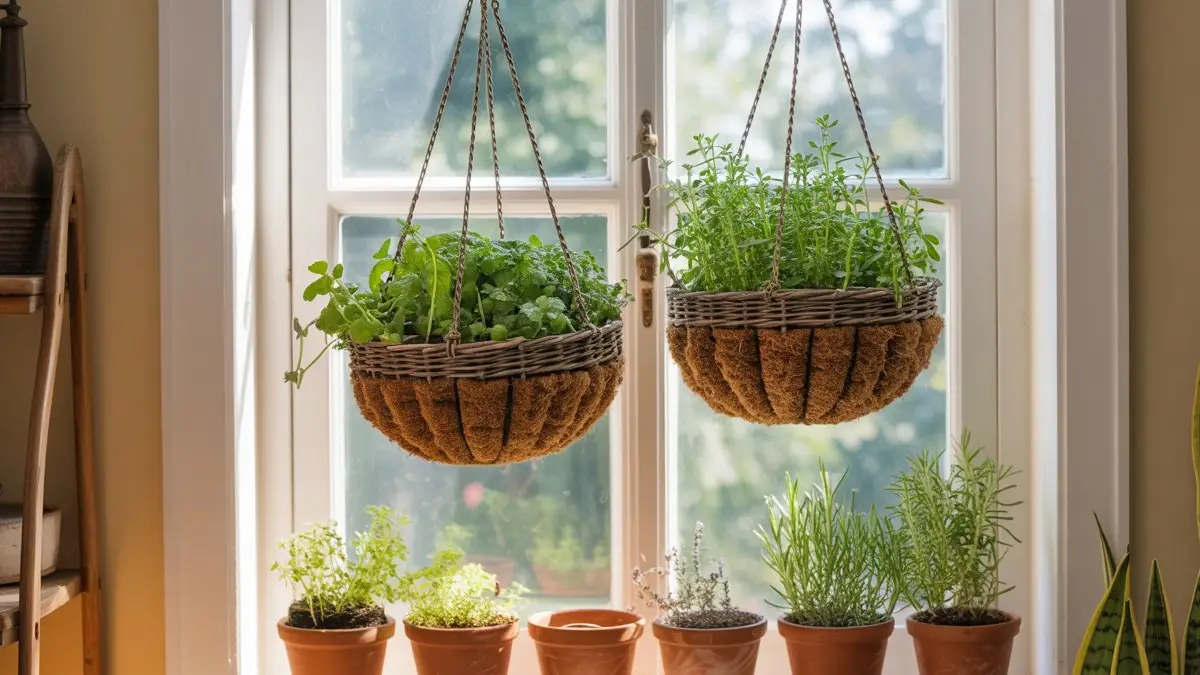
Morning light pours through a cozy kitchen window and wakes a pair of woven hanging baskets lined with coco fiber, packed with mint and oregano that tumble over the rims.
Below them, a neat row of terracotta pots holds rosemary, thyme, and lavender, each rising clean and green above saucers that keep the sill tidy.
This indoor herb garden idea saves space, brings fragrance to eye level, and turns a plain view into a fresh pantry you can snip from in seconds.
Place thirstier herbs in the baskets where airflow is strong and harvest often to keep growth dense. Use a peat free mix with a little compost, then water when the top inch feels dry to the touch.
Rotate pots each week for even sun, and pinch back flower buds to hold flavor. With this setup you can muddle mint for tea, rub rosemary on roast veggies, and scatter thyme over eggs the moment the pan leaves the stove. Guests will ask how your kitchen smells so alive.
4. Cozy Corner Tiered Herb Stand

Warm afternoon light falls into a quiet living corner where a black tiered stand turns unused space into a compact kitchen garden.
On the top shelf sit sleek white planters ready for basil and mint, catching bright light while staying within easy reach of the sofa.
The middle level suits thyme and oregano in smaller stone pots, close enough to snip for soups or tea, and shaded just enough to prevent scorch.
Down low there is room for chives or parsley, which appreciate gentle light and steady moisture from a deep watering every few days.
Use a peat free mix with a spoon of compost, set saucers to protect the floor, and spin each pot a quarter turn weekly to keep growth even. Harvest lightly and often so stems branch and flavor stays bold.
This indoor herb garden idea keeps the room calm, blends with modern furniture, and brings a fresh scent that lifts the mood. Guests will notice the greenery, you will love the easy access during weeknight cooking.
5. Mini Greenhouse Herb Sanctuary
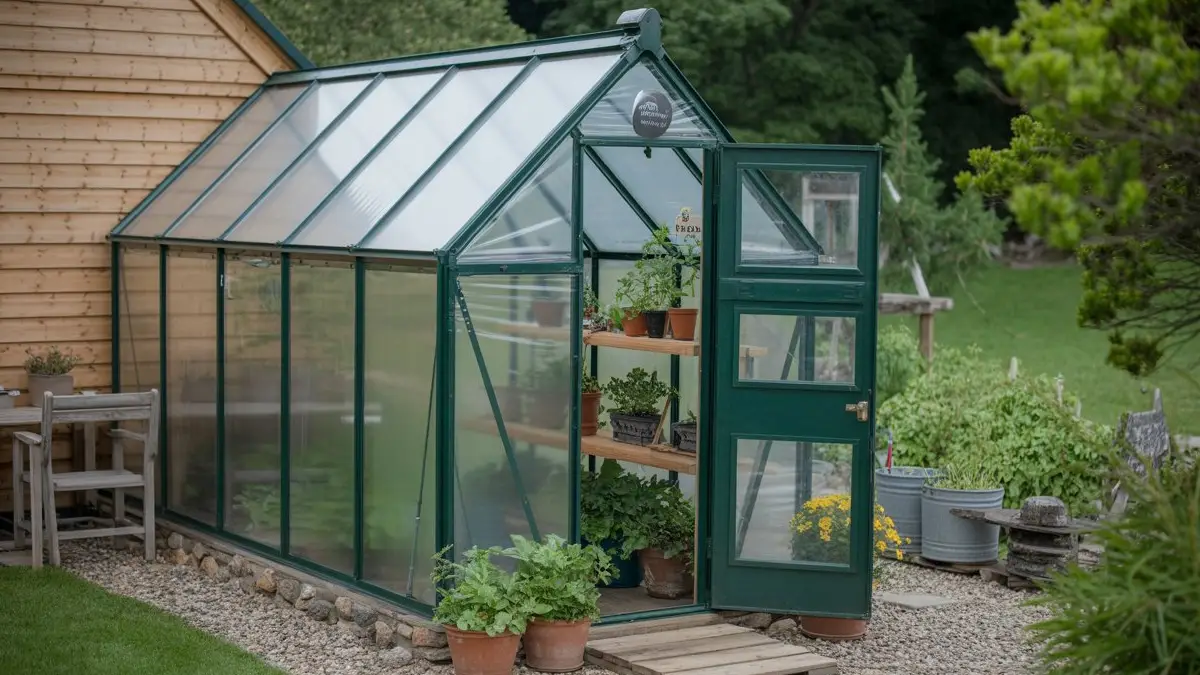
Tucked beside a wooden garden shed, a glass-panel greenhouse gleams under soft daylight, transforming into a peaceful retreat for fresh herbs.
Inside, neat wooden shelves hold potted basil, parsley, and oregano, while larger pots at the base cradle mint and rosemary, soaking in the steady warmth.
The structure traps sunlight and moisture, creating a balanced microclimate that keeps herbs thriving year-round.
Gravel paths around it keep the space dry and clean, and a small wooden ramp makes tending to plants easy after rain.
Use breathable terracotta pots for airflow and choose a compost-rich soil mix to keep roots strong. Open the door on warm days for ventilation and watch as condensation clears, letting herbs breathe.
This indoor herb garden idea blends function and calm, making it just as fitting for small homesteads as suburban backyards. Every visit feels grounding, each leaf holding the scent of something grown with patience and care.
6. Rustic Ladder Shelf Herb Garden

Sunlight filters across a rustic ladder shelf that turns a slim wall into a working herb pantry. Terracotta pots of basil, oregano, and rosemary nest in deep wooden trays, with stenciled labels adding farmhouse charm and quick identification at a glance.
Close to the dining table, fresh leaves move straight from shelf to plate, which makes this one of the most practical indoor herb garden ideas for small homes.
Moisture stays balanced thanks to porous clay and a light compost rich mix that breathes well. A weekly quarter turn keeps stems upright and prevents leaning toward the window.
Trimming tips often encourages bushy growth and a steady supply for sauces, salads, and tea. Hooks on the side hold scissors and a mister so care tools never go missing.
In the evening, a small warm lamp nearby extends daylight for basil without crowding the room. Guests notice the fragrance first, then the texture of aged wood and living greens. You enjoy the calm ritual of watering, clipping, and tasting.
7. Color Pop Windowsill Herb Pots
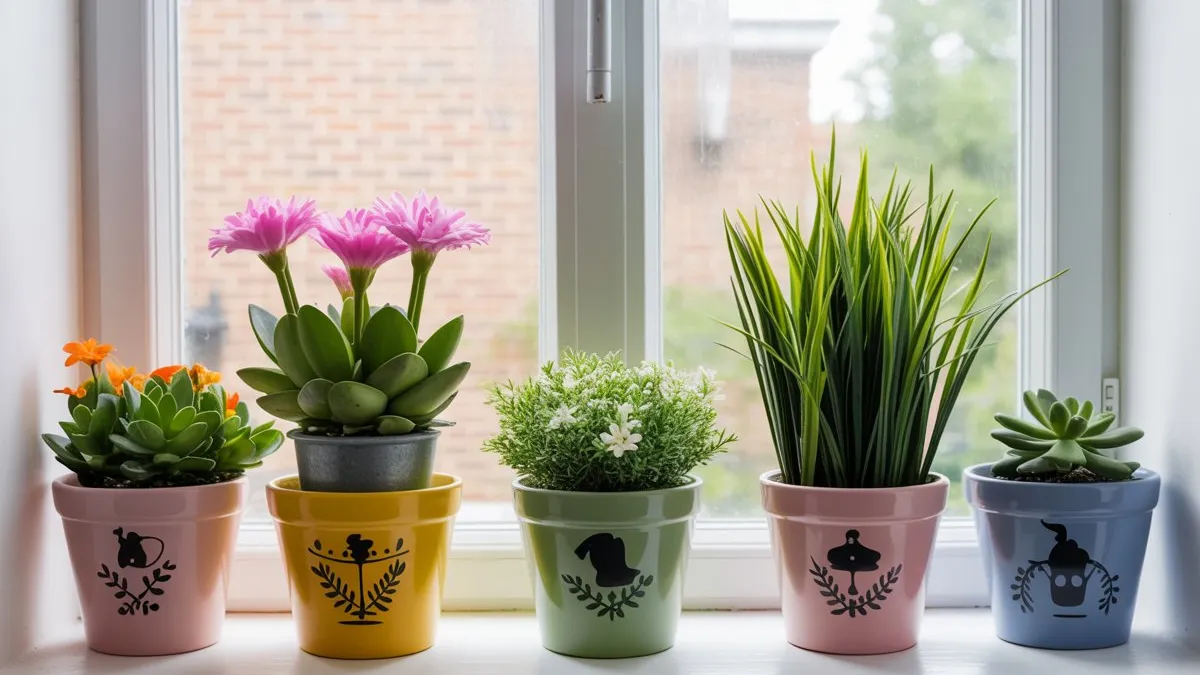
Bright ceramic pots line a sunny kitchen ledge and turn a plain sill into a cheerful indoor herb garden. Soft pink, lemon yellow, mint green, and sky blue planters create a playful palette that makes basil, parsley, chives, and mint feel at home.
Cute silhouettes on each pot double as quick labels, so you grab the right flavor without thinking. A simple setup like this fits small apartments and busy cooks who want fresh leaves within arm’s reach.
Use a peat free mix with a little compost for steady growth, and make sure each pot has a drainage hole with a saucer to keep the ledge dry. Rotate the herbs every week so light hits them evenly, then water only when the top inch feels dry to the touch.
Snip often to keep plants bushy and flavorful, and remove any flowers that try to form. The colors lift the mood on cloudy days while the herbs add fragrance to the room. Guests will spot the charm first, then ask for the pesto recipe.
8. Galvanized Kitchen Island Herb Trough
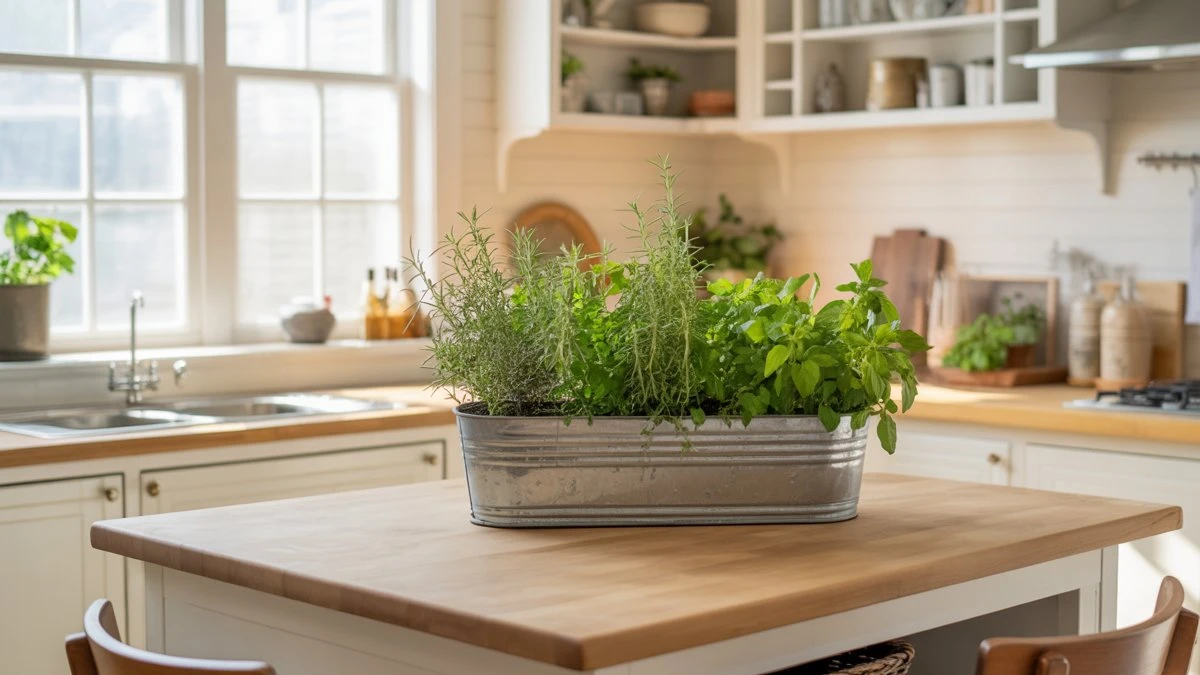
Morning light fills a bright farmhouse kitchen while a galvanized planter steals the show at the island’s center. Packed with rosemary, thyme, and basil, the trough keeps fresh flavor right where chopping and stirring happen.
This indoor herb garden idea doubles as a living centerpiece, adding texture, scent, and a touch of rustic charm to everyday meals. Choose a peat free mix with a small scoop of compost to nourish steady growth.
For drainage, set a shallow gravel layer at the bottom and slip a tray beneath to protect the wood surface. Rotate the planter a quarter turn each week so stems grow evenly toward the window.
Water only when the top inch feels dry and snip tender tips often to encourage bushier plants. A small clip light in the evening stretches usable hours during short winter days.
After a quick harvest, scatter basil over pasta, tuck thyme into a pan sauce, or bruise rosemary for roasted potatoes. Guests will ask how the room smells so fresh before the first bite.
9. Framed Herb Wall Gallery
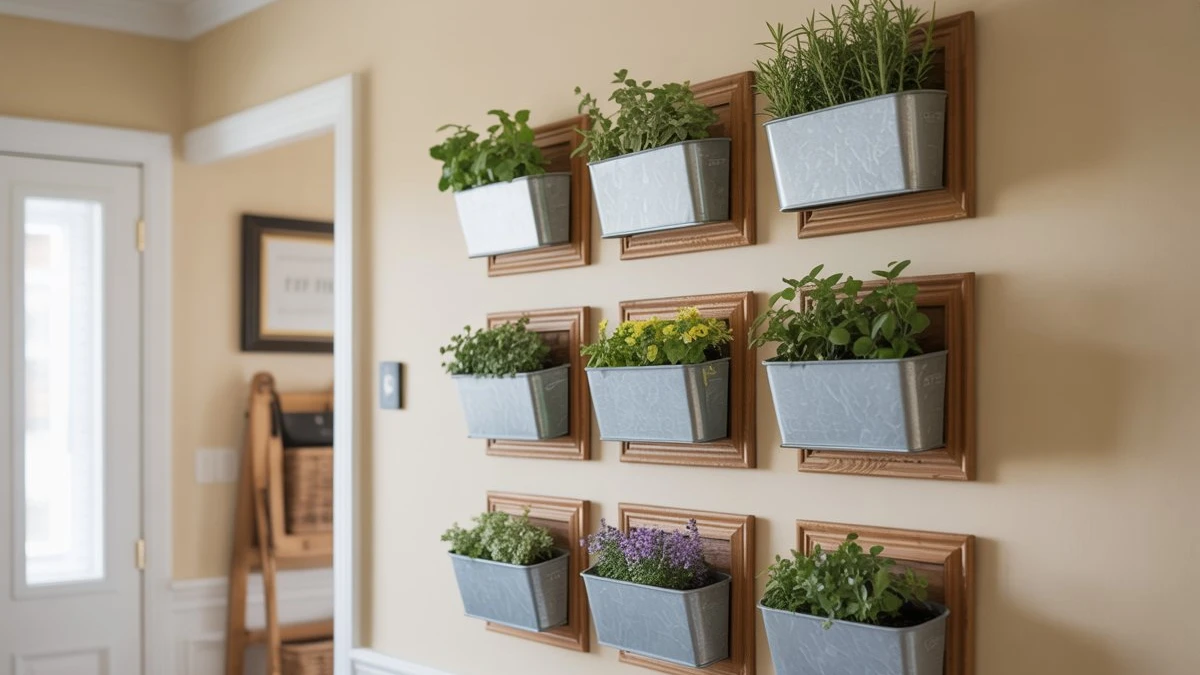
A bright entry wall turns into living art with nine framed planters filled with kitchen favorites, a smart twist for anyone searching indoor herb garden ideas that save space and look beautiful.
Each galvanized box sits in a wooden frame, creating a tidy grid that keeps mint, basil, oregano, parsley, thyme, rosemary, and chives right where you pass by all day.
Place thirstier herbs near eye level for easy checks, and tuck tougher growers higher where light is strongest.
Good results start with a peat free mix and a small scoop of compost, plus drainage holes and hidden trays to protect the paint. Water only when the top inch feels dry, then snip lightly from several plants instead of stripping one bare.
Short trims keep stems branching and flavors bright. A gentle fan in the room helps airflow and reduces mildew, while stick on labels make quick work of harvesting.
Guests see a gallery at first glance, then catch the clean scent that hints at fresh sauces and tea to come.
10. Rolling Herb Cart for Sunny Corners
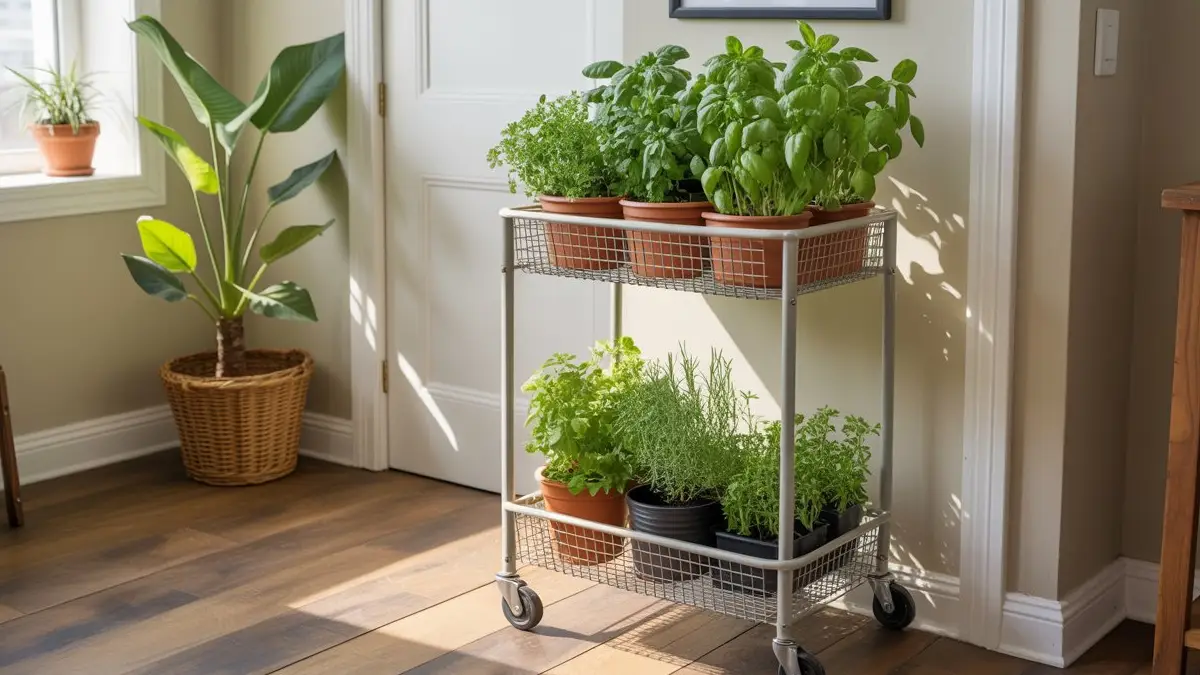
Morning sun reaches a slim utility cart that glides from window to stove with a gentle push.
Terracotta pots on the top shelf brim with basil and thyme, ready for quick pinch harvests that brighten weeknight pasta or omelets.
Down below, parsley, rosemary, and mint soak up dappled light and stay tidy inside wire baskets that allow airflow.
Mobility is the magic here, since you can chase the brightest spot in winter and slide the cart out of traffic during busy hours.
Good results start with a peat free mix and a small scoop of compost for slow nutrition. Add saucers under each pot, then water only when the top inch feels dry to the touch.
Spin the cart a quarter turn every few days so stems grow even and strong. Short trims after cooking keep plants compact and full of flavor.
A small clip light near the window extends daylight on short days. Guests love the scent, and you get a pantry on wheels that looks smart and works hard.
11. Slim Tray Herb Bar
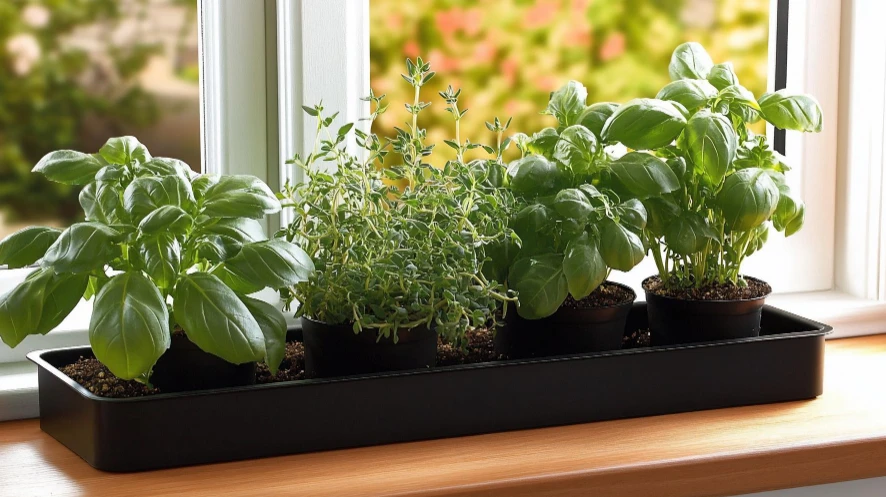
Soft morning light lands on a sleek black tray that corrals four compact pots of basil and thyme, turning a small sill into a practical mini garden.
This simple setup fits the spirit of indoor herb garden ideas that save space and keep flavors close to the cutting board.
Fresh green leaves stay lush thanks to a peat free mix, a thin layer of gravel for drainage, and a tray that protects the wood ledge from stray drips.
Place the planter on an east window for gentle sun, then rotate the pots each week so stems grow straight and sturdy.
Water only when the top inch feels dry and feed with a mild liquid fertilizer every three weeks during active growth.
Pinch basil tips often to encourage branching, and trim thyme lightly to keep a tidy mound with strong aroma. A small clip light nearby can extend daylight in winter.
With a quick snip you can garnish soup, toss pesto, or add a bright finish to eggs, all from a calm green strip that looks clean and works hard.
12. Upcycled Cup Herb Nursery
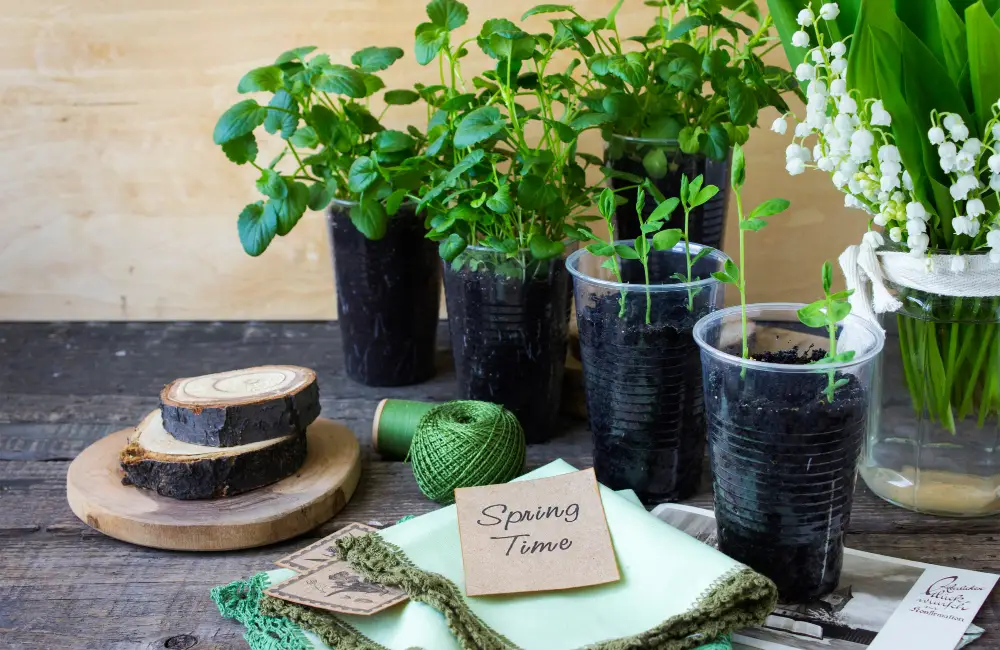
Spring energy fills a rustic tabletop where mint, basil, and young pea shoots sprout in clear plastic cups, a simple indoor herb garden idea that costs very little and grows fast.
Transparent sides let you watch roots form while reminding you when soil needs moisture. Small holes made near the base allow drainage, and a shallow tray underneath keeps the surface clean.
Use a peat free mix blended with a handful of compost and a pinch of perlite for air. Seeds or market cuttings settle easily into this setup, then sit by a bright window for five to six hours of light each day.
Gentle bottom watering keeps stems steady, and a soft fan nearby strengthens growth. As plants stretch, snip tips to encourage branching and save trimmings for tea or omelets.
Handmade tags and a ball of green twine add charm so your starter station looks intentional, not cluttered. When roots circle the cup, shift each herb into a larger pot and enjoy a steady stream of leaves all season.
13. Brick Wall Shelf Herb Showcase
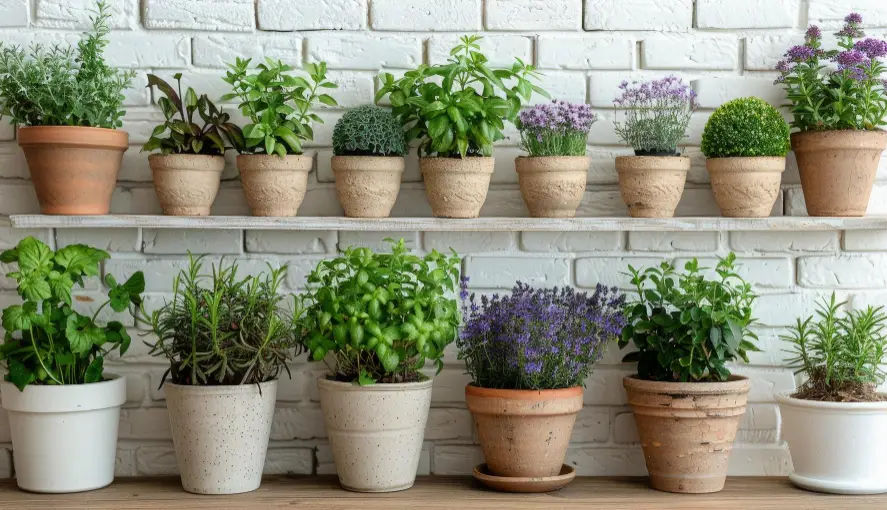
Sun washed brick sets a calm backdrop for two simple shelves packed with living flavor. Terracotta and creamy white pots line the boards with basil, mint, rosemary, thyme, and little domes of lavender bringing color and texture to the room.
This indoor herb garden idea turns a blank wall into a tidy pantry you can snip from each day. Group thirsty herbs in matching pots with saucers, and place tougher growers like rosemary near the brightest edge so they sip stronger light.
A peat free mix with a scoop of compost keeps roots happy while allowing air to move through the soil. Water only when the top inch feels dry, then feed a gentle liquid fertilizer every few weeks during active growth.
Rotate pots a quarter turn weekly so stems stay straight and full, and pinch tips often for bushy plants with rich aroma. A small fan on low encourages airflow and reduces mildew.
Guests notice the neat rows first, then the clean scent that hints at fresh tea, pesto, and roasted potatoes in the making.
14. Herb Rehab Station
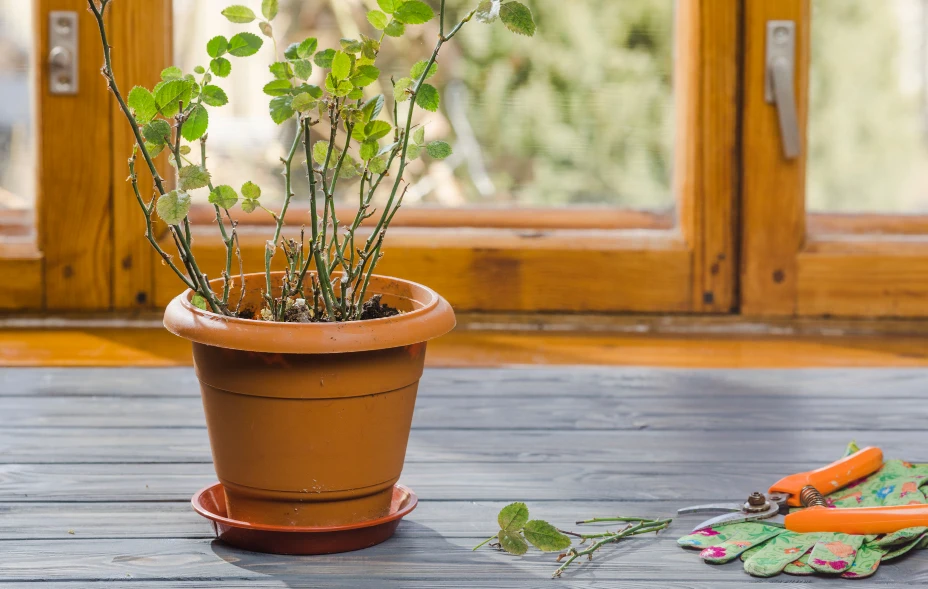
Morning light falls across a terracotta pot and a tidy set of pruners and gloves, setting the scene for a quick herb rescue session. Tired stems bounce back fast with a simple routine that suits rosemary, thyme, basil, or mint.
Start by snipping above a healthy pair of leaves to trigger branching, then remove any weak or crossing growth so air can move through the plant. Spare the youngest tips for the kitchen and let the plant keep its energy.
After trimming, loosen the top inch of soil, mix in a small scoop of compost, and water until a little drains into the saucer. Rotate the pot a quarter turn so every side meets the sun, and keep the window clean for brighter light.
A five minute check once a week keeps bugs in check and catches dry soil before leaves wilt. Save the best clippings for tea, salads, or a pan sauce, and enjoy how fresh growth arrives within days. This small station proves that care can be simple and results can taste amazing.
15. Tabletop Potting for Herbs

Sunlight spills across a rustic work table where a tin bucket, a mound of fresh potting mix, and three hand trowels set the stage for a quick herb upgrade.
This indoor herb garden idea turns any spare surface into a mini planting station that keeps mess contained and tasks efficient. Start by blending peat free mix with a little compost and a pinch of perlite so roots breathe and drain well.
Scoop soil into clean pots with drainage holes, then tuck in basil, mint, or thyme at the same depth they grew before. Firm gently to remove air pockets and water until a trickle reaches the saucer.
Rotate pots toward the brightest window and wipe leaves to keep dust from blocking light. A shallow tray under the workspace makes cleanup simple and saves floors from stray soil.
Label each plant for easy harvests, and keep tools within reach so repotting and top ups happen fast. A short session like this pays off in steady growth and a kitchen that smells bright and green.
16. Picket Fence Planter Herb Row

Morning light brushes a rustic picket planter where basil, thyme, rosemary, and lemon balm sit neatly in slim trays, giving a farmhouse feel to a tiny space.
This setup works indoors near a bright window or a sunroom rail, turning a narrow ledge into a steady source of flavor.
Each tray keeps soil contained and makes watering easy, while the wood backboard supports taller herbs as they reach for the sun.
Start with a peat free mix plus a scoop of compost so roots stay airy and fed. Add a thin layer of gravel beneath each pot for drainage and set saucers under trays to protect the wood.
Rotate the planter a quarter turn every few days and pinch tips often to keep plants compact and branching. Water only when the top inch feels dry and feed a mild liquid fertilizer every three weeks through the growing season.
A small fan nearby improves airflow and reduces mildew. With a quick snip you can finish soups, brighten salad, and scent the room with clean green notes.
17. Rustic Trough Herb Centerpiece
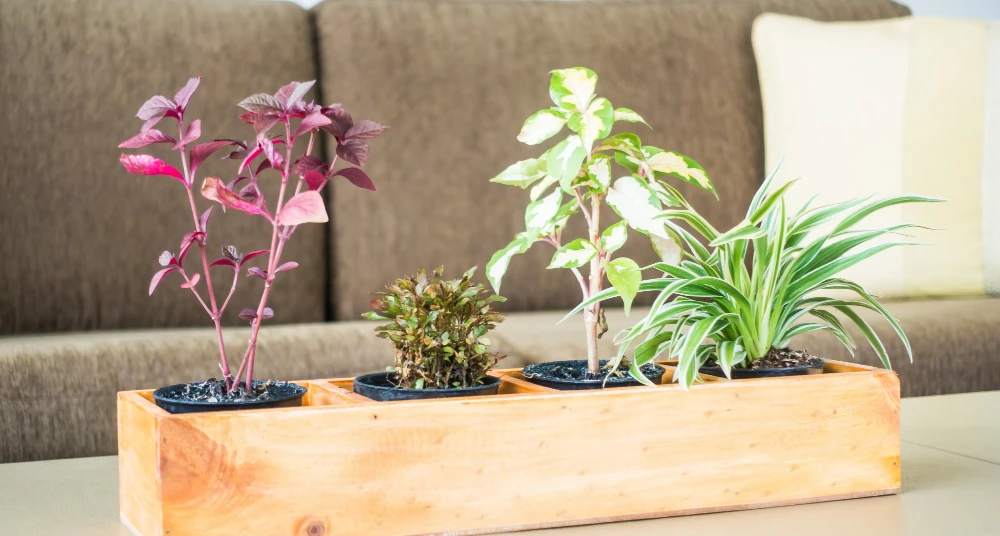
A warm wooden trough sits on the coffee table and proves a slim planter can host a small indoor herb garden with style.
Swap the display plants for kitchen favorites like basil, mint, parsley, and chives, then group them by height so the leaves form a soft green wave.
Line each cubby with a plastic insert or nursery pot to keep moisture contained and make swapping plants simple.
Fill with peat free mix blended with a spoon of compost and a little perlite for air. Tiny stones at the base add drainage and protect roots from soggy soil.
Set the trough near a bright window that offers four to six hours of light and turn the box a quarter each week so stems grow evenly.
Water only when the top inch feels dry and feed a gentle liquid fertilizer every few weeks during active growth.
Pinch basil tips for branching and trim chives with clean scissors to keep new shoots coming. A linen napkin under the box saves the table and adds texture. Guests notice the calm look first, then ask for a sprig for their tea.
18. Seedling Starter Herb Tray
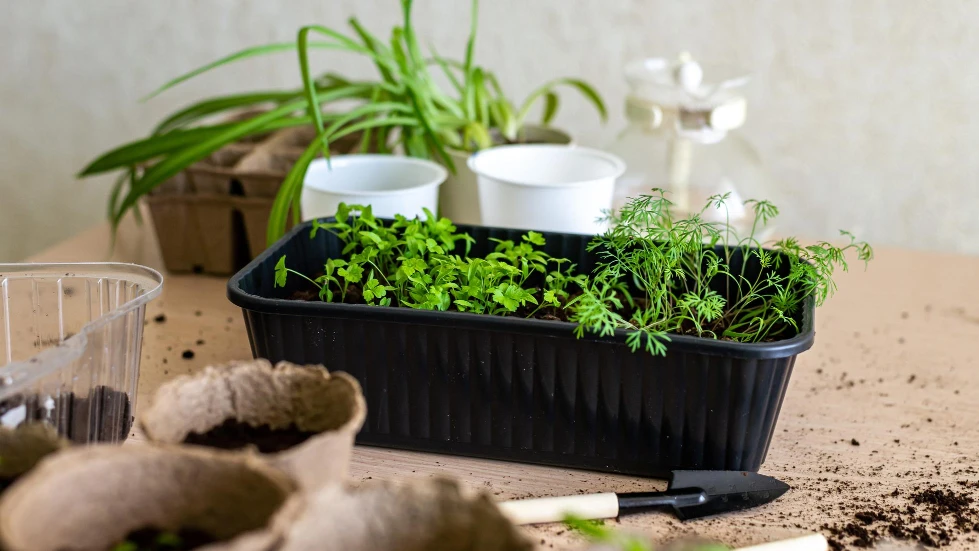
Fresh green sprouts fill a shallow black tray on a tidy worktable, showing how easy it is to start an indoor herb garden from seed. Parsley and dill rise in soft rows while nearby peat free pots wait for the next batch.
A small trowel and mist bottle keep the routine simple and clean. Begin with a light seed mix blended with a spoon of compost and a little perlite for air and drainage.
Sow thinly so each seedling has room, then press gently to make good contact with the soil. Keep the tray on a bright sill for five to six hours of light and use a clear cover for warmth until the first true leaves appear.
Switch to bottom watering by setting the tray in a shallow dish for ten minutes so roots drink without disturbing stems. Trim the first harvest with clean scissors to encourage branching and richer flavor.
When each plant holds several sets of leaves, lift them into individual pots and label them. Soon you will have a steady stream of tender herbs for soups, salads, and tea.
19. Aloe Healing Herb Studio
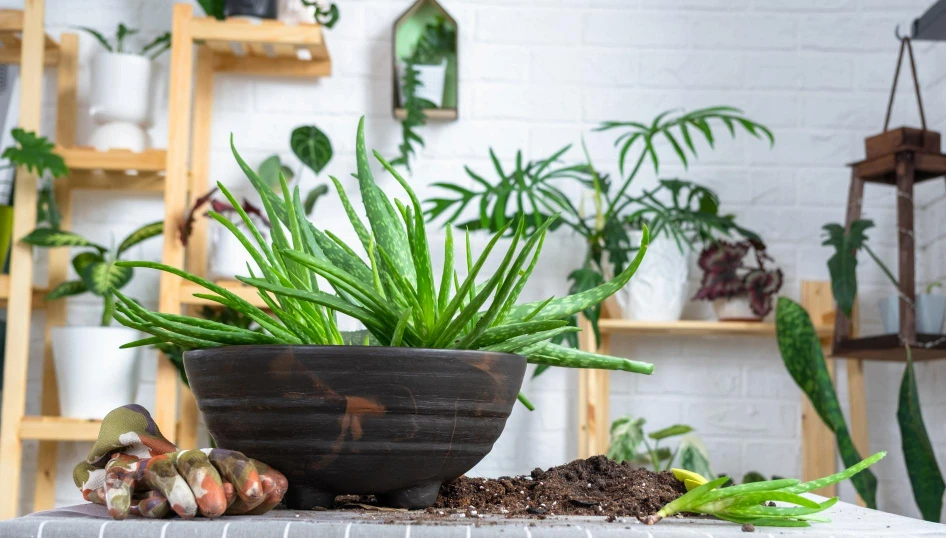
Sun spills across a cozy plant corner where a wide clay bowl holds a vigorous aloe, turning a simple tabletop into a small herbal studio.
This indoor herb garden idea focuses on a soothing staple you can use for minor kitchen burns and dry skin while enjoying sculptural greenery that brightens the room.
Start with a gritty blend of cactus mix and perlite so roots breathe, then add a thin layer of stones at the base for drainage before planting offsets around the mother crown.
Place the pot near a bright window with a curtain that softens midday glare, and water deeply only when soil feels dry most of the way down.
Rotate the bowl a quarter turn weekly for even growth, brush dust from the leaves, and remove spent outer blades to keep the rosette tidy.
Snip a small tip as needed, squeeze the cool gel, and return the rest to the fridge in a sealed jar for another day. A simple cloth under the planter protects the table and adds texture, while a hand shovel and gloves nearby make quick touch ups easy.

